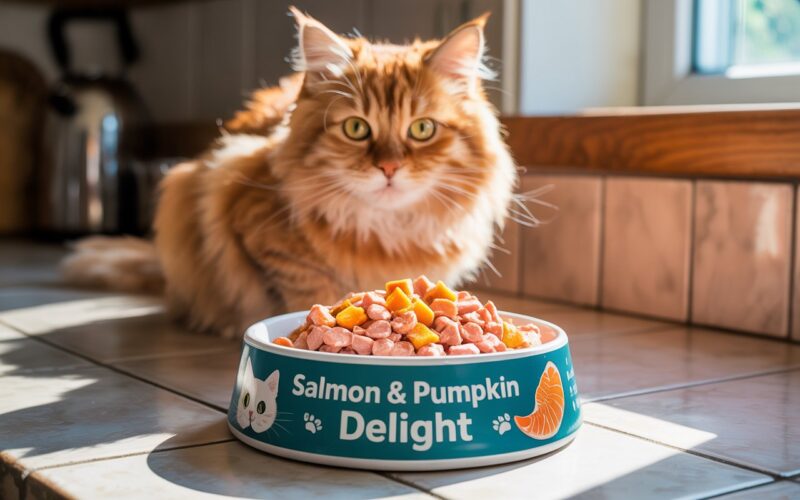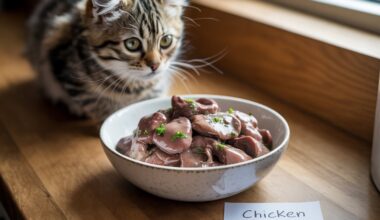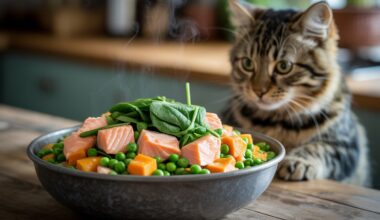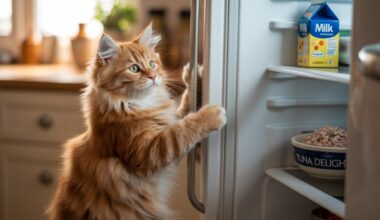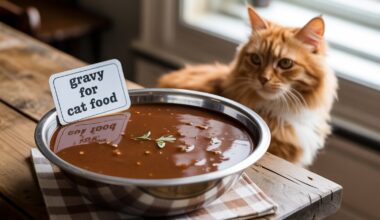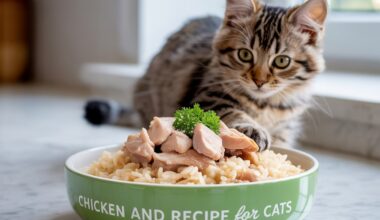I created Salmon & Pumpkin Delight for my cat, cat food recipes with fish is home -made food or supplemental food. Salmon and Pumpkin are usually safe and beneficial material for cats. However, some important things should be kept in mind when preparing a homemade cat meal. Namely:
Veterinary advice ( for cat food recipes with fish)
We need to consult the veterinary physician (especially if you want to use homemade foods as the main source “before making any significant change in the food of our cat. They can advise on our cat’s specific needs and proper nutrition for health conditions. If there is no proper balance in the home -made foods, there may be a lack of essential vitamins and minerals, which can cause nutrients over time. Source : Analysis of recipes of home-prepared diets for dogs and cats published
Using only common ingredients on cat food recipes with fish
Always use plain, cooked ingredients. Avoid using any added salt, sugar, oil, spices or seasonings. Many human foods can be toxic or harmful to cats (e.g. garlic, onions, excess salt).
Treats vs. full meals
The recipes provided here are generally for treats or supplemental food, not a complete and balanced diet. Cats are obligate carnivores and require a diet rich in animal protein and certain nutrients, such as taurine, which may not be available in sufficient amounts in typical homemade recipes.
Best Homemade Cat Food Recipes: Chicken & Pea & 5 more Delicious Recipes
Homemade food is a great expression of love for your pet cat. Fresh meat, preservative-free ingredients—everything may sound good. But the problem is, many times these foods cannot provide all the nutrients your cat needs. And this is where “homemade cat food premix” plays an important role.
Below are a few ways to make homemade “Salmon and Pumpkin Delight” for cats:
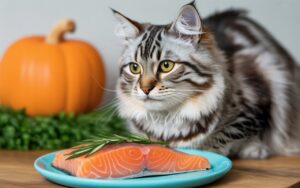
Option 1: Simple Baked Treats (More like cookies/biscuits)
This recipe is good for a crunchy or chewy treat.
Ingredients:
- One 4-ounce can of wild salmon (in water without salt), thoroughly drained, or freshly cooked and deboned
- ⅓ cup of pureed pumpkin (not pumpkin pie filling)
- Half a cup of traditional oats, ground into a fine flour
- One large egg
- Two tablespoons of olive or avocado oil
Instructions:
- Preheat Oven: Set the oven temperature to 325°F, or 160°C.
- Make Oat Flour: In the event that you do not have oat flour, grind traditional oats into a fine powder in a food processor or blender.
- Mix Ingredients: In a bowl, mix together the avocado oil, oat flour, pumpkin puree, egg, and drained salmon (break it up with a fork). Until a dough forms, thoroughly mix.
- Create Treats: Using a small cookie cutter, cut out small “cookies” or thinly roll out the dough (e.g., small circles or fun shapes if you have them).
- Bake: Line a baking sheet with parchment paper and arrange the treats on it. Bake until firm and lightly golden, 25 to 30 minutes.
- Cool and Store: Before serving, allow the treats to cool fully. Keep them in the fridge for three to four days in an airtight container. For extended storage, you can also freeze them.
Option 2: Soft Puree/Topper (Easier to mix with regular food)
This is more of a wet food consistency, great for mixing with your cat’s regular kibble or as a standalone treat.
Ingredients:
- tiny salmon fillet (deboned, cooked, and without seasonings)
- ¼ cup pureed pumpkin (not pumpkin pie filling)
- For the desired consistency, add a few tablespoons of water or unsalted chicken or fish broth.
Instructions:
- Cook Salmon: Bake, boil, or steam the salmon fillet until it is cooked through. Verify that there are no bones.
- Combine and Blend: Put the cooked salmon and pumpkin puree in a blender or food processor.
- To get consistency, blend until it’s smooth. Add a tablespoon of water or unsalted broth at a time if it’s too thick until you get the consistency you want, such as a smoother puree or a thicker pate.
- Cool and Serve: Before serving, let the mixture cool fully.
- Store: Keep for up to two or three days in the refrigerator in an airtight container. For convenient single servings, you can also freeze small portions in an ice cube tray.
Important Considerations:
- Portion Control: Give these sweets sparingly. No more than 10% of your cat’s daily calories should come from treats.
- Allergies and Sensitivities: Watch for any indications of allergies or digestive distress in your cat, such as vomiting, diarrhea, or excessive itching, and gradually introduce new foods.
- Bones: Remove all salmon bones with extreme caution, especially if the fish is fresh, as they can cause internal injury or choking hazards.
- Freshness: Compared to commercial cat food, these have a shorter shelf life because they are homemade and free of preservatives.


